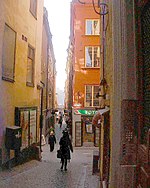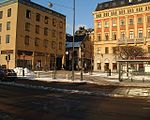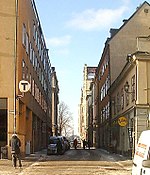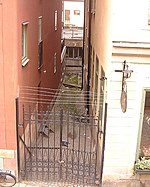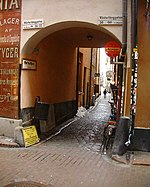Schönfeldts Gränd
Stockholm road stubsStreets in Stockholm

Schönfeldts Gränd (Swedish: "Alley of Schönfeldt") is an alley in Gamla stan, the old town in central Stockholm, Sweden. Stretching south-west from Stora Nygatan to Mälartorget it is crossed by Lilla Nygatan and Munkbrogatan, and forms a parallel street to Kåkbrinken and Lejonstedts Gränd. Before the street names of the old town were revised in 1885, the part east of Lilla Nygatan was known as Schönfeldts gränd, while the western part was called Prechtens gränd ("Alley of [the] Precht").
Excerpt from the Wikipedia article Schönfeldts Gränd (License: CC BY-SA 3.0, Authors, Images).Schönfeldts Gränd
Lilla Nygatan, Stockholm Gamla stan (Södermalms stadsdelsområde)
Geographical coordinates (GPS) Address Nearby Places Show on map
Geographical coordinates (GPS)
| Latitude | Longitude |
|---|---|
| N 59.323611111111 ° | E 18.068888888889 ° |
Address
Lilla Nygatan
Lilla Nygatan
114 27 Stockholm, Gamla stan (Södermalms stadsdelsområde)
Sweden
Open on Google Maps


